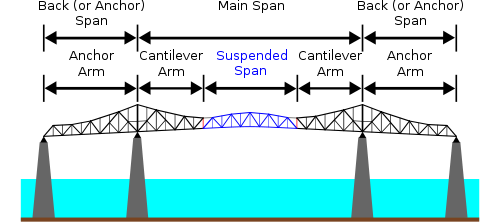Types of bridges
No physics project is truly complete without mentioning F=ma. F=ma is Sir Isaac Newton's 2nd law of motion and states that Force=mass times acceleration. This important property pertains to many aspects of engineering including, as you may have guessed, bridges!
When it comes to bridges, accelleration is due to gravity. So at any given moment, there is a total force downward on the bridge equal to: mass of the bridge plus the vehicles on the bridge times the acceleration of gravity. In order for the bridge to maintain an equilibrium, it must have a normal force equal upward equal the force downward, for a total net force of 0. Creating this force to negate the force due to gravity can be done in a number of ways, leading to our different bridge designs. Here I will just list 3 of the many possible designs.
Beam bridges
Beam bridges are one of the most simple and intuitive bridge forms. Just think, if you were to try and get across a stream how would you do it? A common method is just to law down a plank stretching from 1 bank to the other. This is a form of a beam bridge. These bridges are supported at either end by an abutment. If you are still unsure of what a beam bridge is, or are unfamiliart with the word abutment, refer to the picture below.
Cantilever bridge
In the 19th century, engineers realized that a continuous bridge across multiple supports would distribute the load bewtween them. This resulted in what is now called a Cantilever bridge. The first Cantilever bridge was built in 1867 in Germany. A Cantilever bridge has a portion that acts as an anchor that sustains another portion which extends beyond a pier. This can be almost thought of as a counterbalance. This allows for a bridge to be built without needing temporary structures to support main stretches.

The bridge in the picture below was built in 1876 in Kentucky. It is a cantilever bridge as well as a National Civil Engineering Landmark.

Suspension bridge
The first suspension bridge dates back to 1430. Suspension bridges have cables attached to pilliars. They use the tension in these cables and compression in the pillars to support a normal force that will cancel out the force of gravity. The force due to gravity is transfered to the cables, then to the pillars, then to the ground. This allows for longer main spans than with any other type of bridge. Another big advantage of this type of bridge is that it allows for the main stretch to be built with little to no access from below, meaning that a bridge over water can be buil without interruption to the waterway.
